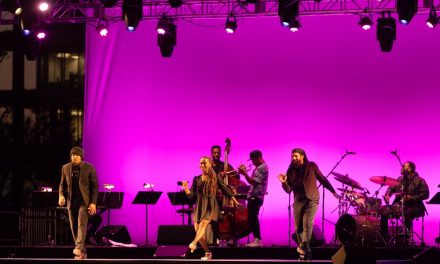I grew up watching the 1997 HBO special “STOMP Out Loud” as often as I possibly could. At the time, my older brother was a drummer, and I was in tap classes every week. STOMP was aspirational for us both; it bridged the gap between our respective then-hobbies and was the only piece of media we’d both sit still for.
Upon hearing the company would be touring to The Soraya this month, I was prepared to be transported back to my childhood—I just didn’t realize how close to the original the choreography would be. STOMP’s unique combination of found-object percussion, rhythmic (tap or flamenco or juba) dancing, and theatrical humor made its way to iconic after its Broadway run. As a dancer, I guess I sort of assumed that this innovative mode would leave room for new iterations and refurbishments. But once it hit Broadway, it must have been frozen after previews and never really freshened. The choreography that went up last night, while performed by new cast members, was almost exactly the same as in the special I so loved.
Ivan Salazar opened the show strong as the leader of the group, sparking audience engagement quickly. Jordan Brooks, Joshua Cruz, Alexis Juliano, Riley Korrell, Cary Lamb Jr., Serena Morgan, and Cade Slattery formed the rest of the company for the evening: they didn’t waste much time in getting to it, bringing rhythms together for an impressive first full-cast number. The cast remains tightly precise even as tempo increases exponentially, the mark of a well-drilled and well-cleaned show. And in STOMP, the truth is that performers can’t cheat the choreography or hide mistakes, because the sounds are a dead giveaway for errors.
These artists are particularly adept and incredibly capable at this very specific skill—creating a set of high-energy rhythms and looking good performing them for a viewing audience. They all have background experience in percussion (drum corps) or tap dance, some in broader practices of dance or music. The two-hour show (without intermission—they’re confident that you don’t need a break) features many more virtuous numbers and a few less-exciting ones. These slower pieces give the cast a break and introduce dynamic shifts so that faster numbers are still exciting, but even so it felt as though for the adagio certain performers were phoning it in.
One number begged more from both dancers and choreographers. In this piece, the cast makes noise by tapping rubber pipes on the floor to make a hollow chorus. They’re perched near the ground, but they only have one method of travel: they just put one foot in front of the other and amble awkwardly in a squatted position rather than sliding, shifting, or rolling. At this low level, the cast seems rather uncomfortable with the floor, which is ironic given that their entire act is based on groundedness. A bit more research at this low height and a trace of workshopping might make the number a bit smoother.
Throughout the evening, Salazar led the cast through the slower numbers with his captivating stage presence. Morgan stood out as well, by adding her own dancing vocabulary into the mix, all within the restraints of the choreography and her assigned rhythms. The Vaudevillian humor of the show—all physical, very few words—grew a bit tired by the end, but the cast remained lovable, nonetheless.
It’s impossible not to participate as an audience member at this show. Its choreographer-creator-directors Luke Cresswell and Steve McNicholas take full advantage of the call-and-response mechanism, and you can’t resist returning the call. In fact, if you purchase the branded drumsticks in the lobby, you won’t be allowed to pick them up until after the show; it seems they’ve had some audience members get a little too excited with their new merchandise. And I can’t say that I’m not one of those audience members—though just the same as it always was, STOMP is still an entertaining and virtuosic classic for the stage.
Written by Celine Kiner for LA Dance Chronicle, February 17, 2020.
Featured image: STOMP – Photo by Luis Luque | Luque Photography









